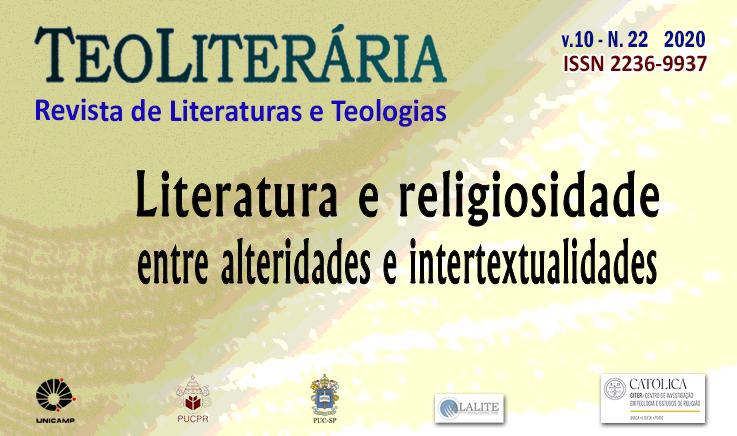Da poesia ao mistério divino: O itinerário mistagógico dos hinos do Apocalipse
DOI:
https://doi.org/10.23925/2236-9937.2020v22p89-103Keywords:
Apocalipse, Hinos, Mistério Divino, Poesia, MistagogiaAbstract
O livro do Apocalipse de São João possui uma beleza singular por sua linguagem simbólica e mensagem de esperança. Na sua parte central (4,1–22,5), há poemas, classificados como hinos, dirigidos a Deus e ao Cordeiro. Eles propõem ao leitor um itinerário mistagógico desde o reconhecimento de Deus (4,8-11) e do Cordeiro (5,9-14); passando pelos seus atributos (7,10-12); a percepção de sua atuação (11,15-18; 12,10-12); o louvor aos seus juízos (15,3-4; 16,5-7); culminando com o Aleluia final (19,1-8), que conclui esse percurso em uma postura reverente a Deus por seu reinado e um convite às núpcias com o Cordeiro. Apresentaremos os hinos inseridos no conjunto da estrutura literária do livro do Apocalipse e a função que eles exercem de síntese poética do drama narrado. Em seguida, abordaremos a mistagogia dos hinos do Apocalipse a fim de compreender como se mostra a ação divina e sua relação com o meio e com a humanidade. Não nos deteremos demasiadamente na análise exegética, mas a presumiremos para uma ênfase mais literária e teológica. Finalmente, consideraremos Deus como mistério fascinante que propõe a comunhão a partir de Cristo, o Cordeiro imolado.
References
AUNE, David. Revelation 1-5. Dallas: Word, 1997.
AUNE, David. Revelation 17-22. Nashville: Thomas Nelson, 1998b.
AUNE, David. Revelation 6-16. Nashville: Thomas Nelson, 1998a.
BAUCKHAM, Richard. The Theology of the Book of Revelation. Cambridge: Cambridge Press, 1993.
CASALEGNO, Alberto. E o Cordeiro vencerá (Ap 17,14): leitura exegético-teológica do livro do Apocalipse. São Paulo: Loyola, 2017.
MENDOZA-ÁLVAREZ, Carlos. Deus ineffabilis: uma Teologia pós-moderna da revelação do fim dos tempos. São Paulo: É Realizações, 2016.
MORGEN, Michèle. Comment louer Dieu, “Celui qui siège sur le trône et l’Agneau”?: Étude sur la contextualization et la fonction des passages hymniques dans l’ensemble du livre de l’Apocalypse. In: ACFEB. Les hymnes du Nouveau Testament et leurs fonctions. Paris: Cerf, 2009, p. 209-237.
MUELLER, Ekkehardt. Christological Concepts in the Book of Revelation: the Lamb Christology. Journal of the Adventist Theological Society, v. 22, n. 2, p. 42-66, 2011.
NAM, Daegeuk. The “Throne of God” motif in the Hebrew Bible. Michigan: Andrews University, 1989.
OSBORNE, Thomas. “Récitez entre vous des psaumes, des hymes et des cantiques inspires” (Ep 5,19): Un état de la question sur l’étude des “hymnes” du Nouveau Testament. In: ACFEB. Les hymnes du Nouveau Testament et leurs fonctions. Paris: Cerf, 2009, p.57-80.
OTTO, Rudolf. O sagrado. Lisboa: Edições 70, 2005.
PAUL, André. Doxologie, liturgie et histoire dans l’Apocalypse. In: SIMOENS, Yves; THEOBALD, Christoph. Sous le signe de l’imminence: l’Apocalypse de Jean pour penser l’histoire. Paris: Médiasèvres, 2001, p. 63-76.
SEAL, David. Shouting in the Apocalypse: the influence of First-Century Acclamations on the Praise Utterances in Revelation 4:8 and 11. Journal of the Evangelical Theological Society, v. 2, n. 51, p. 339-352, 2008.
STEFANOVIC, Ranko. The Background and Meaning of Sealed Book of Revelation 5. Michigan: Andrews University, 1995.
VANNI, Ugo. La struttura letteraria dell’Apocalisse. Brescia: Morcelliana, 1980.
WENGST, Klaus. Pax Romana: pretensão e realidade. São Paulo: Paulinas, 1991.
Published
How to Cite
Issue
Section
License
Copyright (c) 2020 Teoliteraria - Journal of Literatures and Theologies (On Line) ISSN 2236-9937

This work is licensed under a Creative Commons Attribution 4.0 International License.
TeoLiteraria – Journal of Literatures and Theologies owns the copyright of all published material. The whole reproduction of the articles of this Journal in other publications or for any other purpose, by any means, requires a written permission of the editor of this journal. Partial reproductions of articles (abstracts, more than 500 words text, tables, figures and other illustrations) must have a permission written by the publisher and the authors.

